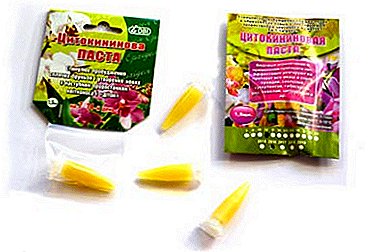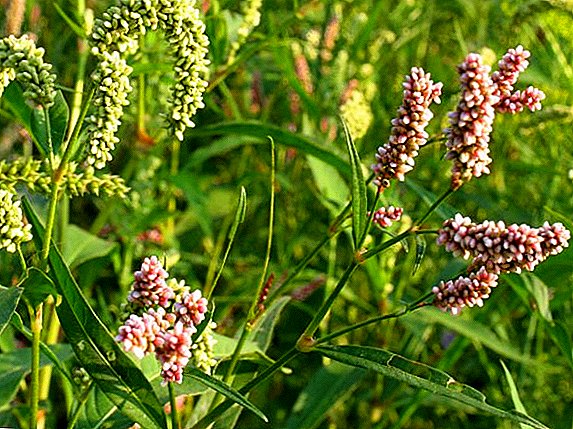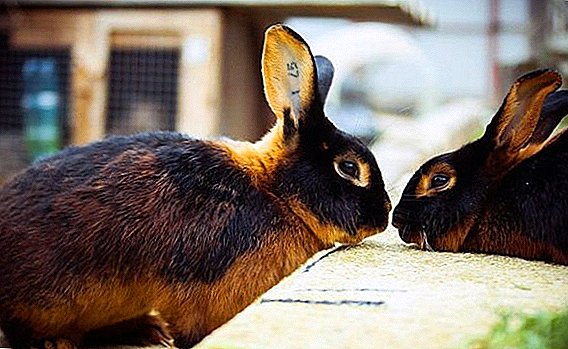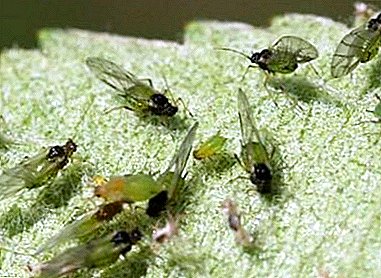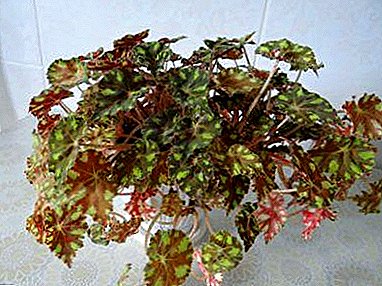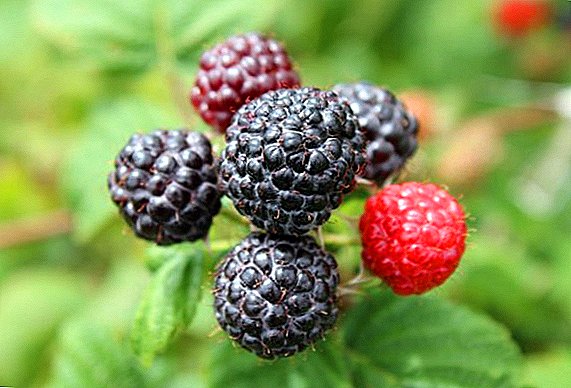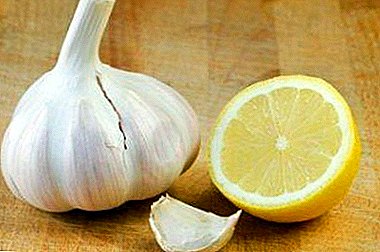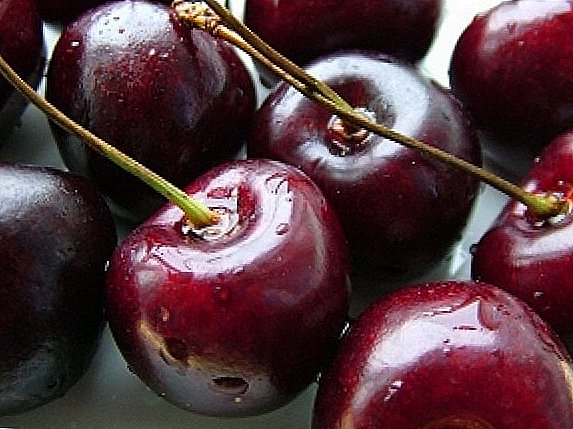
The dream of any sweet cherry lover is to feast on berries all year round. Or at least extend the shelf life of berries. But it is best not to choose a variety with a long shelf life, and plant on its site the sweet cherry of a late ripening period.
Thus, when the berries from the early sweet cherry tree are already torn off for a long time, eaten and rolled up in banks, the later ones will only begin to ripen. It is about these varieties and will be discussed below.
Variety of late ripe sweet cherry "Bryanochka"

This variety of sweet cherries, the berries of which ripen rather late relative to other varieties, was obtained by selection methods. In particular, to obtain it were used such a variety as "8-14", crossed with the cherry "Red Dense".
The berries are medium in size.. The most common sizes range from 4.7 to 7.1 grams. The height of ripe berries is on average 2.1 centimeters, its width is 2 centimeters, and its thickness is 1.9. The shape of the cherries of this variety is broadly heart-shaped. Accordingly, the top of the fruit is round, and their base is flat. In appearance they are deep dark red, very attractive, have a high presentation.
The pulp and juice that it contains are found in the cherries of the Bryanochka variety, like the skin has a dark red tint. The structure of the pulp is very dense, rich in sweet taste. Evaluation of the taste of berries, set by professional tasters, is equal to 4.7 points out of 5.
The sugar content in the biochemical composition of the flesh of the cherry is 49 times higher than the acid content. Also, 100 grams of the fruit contains approximately 15.6 mg of vitamin C, which makes the berries also very useful for consumption.
The bone of the berry has an oval shape with a pointed top and an oval base. Its weight is on average 0.31 (6.6% of the total weight of the berry). It has a brown color. The positive quality of this variety is that the bone is easily separated from the pulp.
The maturity of the fruits comes in late, around mid-July.
The size of the Bryanochka sweet cherry tree is average, which is typical of all varieties of sweet cherry. The crown of a tree is very rare, has a rounded oval shape. Shoots on the tree are formed strong, straight with medium-sized buds. In the vegetative and generative stages, the buds of the tree are ovoid.

The leaves are formed very large, oval-shaped. The top and bottom of the leaf of this tree is pointed. The inflorescences that form on the tree at a later date (which explains the late dates of ripening berries), consist mainly of 2-3 flowers. Flowers differ in medium size and saucer-shaped corolla. The arrangement of the petals of the Cherry "Cherry" flower is free, without touching each other. They are white in color.
Cherry "Bryanochka" characterized by very high yields. In particular, on average, 93 centners of berries are harvested from one hectare of trees. The maximum yield per hectare is 308 centners. The tree gives the first harvests only on the 5th year after its planting at a permanent place of growth.
As we have described above, the variety is capable of producing very high yields. In addition, the fruits of cherries "Bryanochka" are distinguished by an extraordinary taste and a very beautiful appearance. In addition, both the tree and its buds and shoots have a fairly high level of resistance to winter frosts and spring frosts. Resistance to to such disease, as coccomycosis also very high.
The main disadvantage of the Bryanochka sweet cherry is that the grade belongs to sterile, that is, not capable of self-pollination. Therefore, it is recommended to plant such varieties of cherries as “Tyutchevka”, “Iput”, “Veda” along with “Bryanochka” on the site.
Thanks to these varieties, you can get high-quality pollination and excellent yields of berries. Also, it is worth noting the late dates of onset of fruiting (5 years) and the average degree of resistance to diseases such as cholerosis and moniliosis.
It is also interesting to read about autumn cherry care.
Variety of late ripe cherries "Michurinskaya Late"

Another variety of late ripening, which was also obtained through research and development.
During the period of removable maturity fruit This sweet cherry variety is medium in size, and weigh about 6.5 grams. The form they have is very beautiful, wide heart. Also, the berries are characterized by a rounded top and the same base, but with a deepening of medium size. The ventral suture is, but it is unobtrusive. The skin of the fruit is colored dark red, it has no subcutaneous spots.
The flesh of the Michurinskaya Late cherries is also of characteristic red color. Juiciness her highIt tastes pleasantly sweet. The ratio of sugars and acids in the composition of the berries of this variety is 1/29. The amount of vitamin C contained in 100 grams of berries is 9.79 mg.
Stone in ripe berries has a medium size. It is characterized by an oval shape, without bulges and serrations. Also, distinguished by a smooth surface and good separation from the pulp. The stem is short and not thick enough, but it can easily separate from the branch.
The ripening dates of the cherries of the Michurinskaya Late variety are fully consistent with their name, since their consumer maturity comes only after crossing mid-July. Thus, they ripen even later than the variety "Bryanochka". According to its purpose, the berries are universal. Very well suited for the preparation of various preservation. Less suitable for drying, because they have medium size.
As with the variety described above, the Michurinskaya Late Later sweet cherry in adult fruiting age reaches medium size. At the same time the tree differs in promptly fast rates of growth. The crown of the cherry is rounded-dump. Branches raised, moderately thickened crown. Differs in brownish color of bark. Fruits are formed mainly on the bouquet branches, regardless of their age.

Shoots This variety is different in that they have a thick basegrow straight and naked. The color of the shoots is also brown; there is a bit of a skull on them. The buds are strongly deviated, of medium size, in shape they are ovate.
The leaves are medium sized and narrowly ovate. The surface of the leaves is smooth, painted in dark green color. Inflorescences are formed on the tree in average terms. They consist of 2-3 large white flowers. The form of flowers is rosy with beautiful rounded petals.
It is also worth noting high and regular sweet cherry yield "Michurinskaya Late", the average indicators of which are equal to 80-140 centners from 1 hectare. True, the tree begins to bear fruit relatively late - only after reaching 5-6 years of age at a new growth place.
The variety is greatly appreciated by many gardeners for its high yield and excellent fruit quality. Indeed, besides the fact that berries ripen relatively late, as well as have excellent taste, they are also very well suited for transportation over long distances.
It is worth noting that the crops in a tree are regular. The variety has a high degree of resistance to low winter temperatures. and not afraid of droughts. Defeats such a disease as coccomycosis in "Michurinskaya Late" sweet cherry were not observed.
Besides the fact that the tree begins to bear fruit late, it is also not capable of pollinating on its own. Pollination occurs only if such sweet cherry varieties as "Pink Pearl" or "Michurinka" grow next to it.
Although tree and tolerates low temperaturesHowever, the defeat of the wood by the frost cherries significantly reduces its durability. This cherry reproduces only in the way of budding, when a varietal shoot is grafted onto seedlings of cultivated varieties of cherry or clone rootstocks of Vladimirskaya sweet cherry.
Care for late ripening varieties of sweet cherries
Cherry varieties with late ripening berries completely begin their vegetative period. In the flowering period, they enter either late or on average, the period of fruit formation in them lasts longer, which requires much more resources of the cherry tree resources. For this reason, and care for such cherries is slightly different.
About pruning rules

Much attention to the formation of crown cherries do not need to be paid. But still, it is better to cut branches in tiers so that the lowest branches are the longest, and each next to the top tier is shorter than the previous one by 5-8 centimeters. The main conductor should always remain the longest, speaking 10 centimeters in front of the other branches.
The rest of the pruning should be directed to the removal of bad branches that are no longer able to bear fruit. After all, during the growth period, the branches can be damaged both by the weight of the crop, and by the spring heavy snow, and under the influence of the wind or pests. You need to cut them very carefully.
If the branch is thin - it is better to cut with a garden knife. Places cuts worth brushing and gloss over with the help of a garden warrior. It is recommended to prune the branches of cherries in the spring, so that the cuts will heal faster and not be damaged by frost.
Top dressing - an important stage of care

Top dressing plays a very important role for the cultivation of sweet cherries. In particular, it is very important that the tree has enough nutrients during the fruiting period. Therefore, it is possible even in the autumn before the very frost under a 20-cm layer of soil plant organic fertilizersthus fertilizing the whole circumferential circle.
Urea, rich in nitrogen, has a very good effect on tree growth and its vitality. It is not recommended to make a lot, for 1m2 of soil no more than 200 grams of this fertilizer.
These substances, having decomposed and sank to the roots in the spring, will very well nourish the cherry in the period of flowering and fruit formation. So that the fruits could grow well and be fed with taste, in the spring it doesn’t hurt to add superphosphates to the soil in the amount of 120-150 grams per 1m2 of near-wellbore soil.
It is very important to bear in mind that fertilize the sweet cherry should be with some frequency. In the first year after planting, the tree will not need additional feedings. On the second, only urea can be added. But already in the third year after planting, it will be useful to combine both mineral and organic fertilizers. However, the latter should be used to feed the cherries no more than 1 time for 2-3 years.
Watering a late ripe cherry
Like any other varieties, these cherries love water very much. Therefore, they should be watered regularly, at intervals of one month. During periods of drought, the number of irrigations increases, during periods of rain - decreases. On 1 tree, about 3-4 buckets should be used at a young age, in the period of fruiting - about 6 buckets.
It is not recommended to water plentifully sweet cherries in the period of ripening of fruits. Too much water may cause cracking of the cherry berries.
Preparing late cherries for the winter

Preparing for winter these varieties of cherries is no different from the preparation of other varieties. Need to dig up the soil around the cherry, water it abundantly so that the earth is completely hydrated.
Due to this, the soil will not freeze, and the tree will have a sufficient amount of moisture and air. The only difference is that for this type of sweet cherries it is necessary to feed the soil until autumn, and not only in spring.
Chereshin protection from pests and diseases
Even if the variety is resistant to diseases, it is still recommended to periodically process it against possible infection. In particular, during the blooming of sweet cherry buds and the isolation of buds, it is recommended to treat the tree with such preparations as Horus and Aktara.
Further, at the end of flowering and during the formation of the stalk fossa, the cherry is sprayed with "Aktelik" and "Horus". During the growth of the fruit will save them from cherry flies and aphids spraying drug "Aktelik". After harvesting, the danger of contamination of cherries with diseases such as coccomycosis and nodules is not eliminated, so the tree can be sprayed once more with the help of Horus.
Rescue the bark from the rodents can be and method strapping sacking and spruce, so you protect the tree from pests and frost.
To protect the sweet cherry from pests in the fall, when mice are particularly active, you can simply lay out the poison near the burrows.
Planting rules late varieties of cherries

Before you start planting cherries, it is very important to choose the right place and time. Spring is best for planting cherries., because in the fall there is a high risk of frostbite of young shoots. The place for planting cherries should be sunny and windless. The northern winds and stagnant cold air pose a great danger to the sweet cherry.
The pit is digging for prematurely, you can prepare it since the fall. The depth of the pit and the width must be at least 60 centimeters. Topsoil dug out of the pit is mixed with organic fertilizer and poured into the bottom of the pit so that a mound is formed.
In the spring you need on top of this mound spread the roots of a saplingby lowering it into the pit so that the root collar remains above the ground. Then we slowly fall asleep a hole, gently compact the soil and water it abundantly. After a few days, the soil around the sweet cherry should be mulched.


